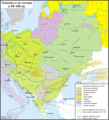Datoteka:Slav-7-8-obrez.png

Veličina ovog prikaza: 544 × 599 piksela. Druge rezolucije: 218 × 240 piksela | 436 × 480 piksela | 698 × 768 piksela | 930 × 1.024 piksela | 1.860 × 2.048 piksela | 3.051 × 3.359 piksela.
Izvorna datoteka (3.051 × 3.359 piksela, veličina datoteke/fajla: 339 kB, MIME tip: image/png)
Historija datoteke
Kliknite na datum/vrijeme da biste vidjeli tadašnju verziju datoteke.
| Datum/vrijeme | Minijatura | Dimenzije | Korisnik | Komentar | |
|---|---|---|---|---|---|
| aktualna | 17:13, 12 august 2023 |  | 3.051 × 3.359 (339 kB) | Gyalu22 | Reverted to version as of 13:16, 23 October 2022 (UTC) Look at the atlas, don't do your own research |
| 19:43, 1 juni 2023 |  | 3.051 × 3.359 (309 kB) | Shibbolet3579 | enice was still in the Byzantine Empire at this time. Avars were also present around Vienna and in central Transylvania, evidenced by graves & toponyms. There was a linguistic contact between Albanians and Vlachs, evidenced by the non-Slavic words present in both languages. Placed the Etelköz of the Magyars and the Crimean byzantine Greeks. South-Slavic toponyms (as Trnava for "tip, hillock, mound") evidenced a South-Slavic presence in southern Transylvania. Concerning the Eastern romance spe... | |
| 15:16, 23 oktobar 2022 |  | 3.051 × 3.359 (339 kB) | Gyalu22 | Reverted bad faith edit, restored to version as of 26 July 2011. The Westermanns Atlas is an irrelevant source for the previous map, as only the Southern Carpathians are shown as possibly inhabited by the Wallachians. | |
| 17:09, 28 april 2014 |  | 3.051 × 3.359 (302 kB) | Spiridon Ion Cepleanu | Bulgarian kingdom & east-romance vlachs according with the universitary atlases of history and the Grosser Atlas zur Weltgeschichte, dir. Hans-Erich Stier, Westermann, 1985, ISBN 3-14-10-0919-8, pp. 50, 55-57, 61 & 64. | |
| 20:27, 26 juli 2011 |  | 3.051 × 3.359 (339 kB) | Koryakov Yuri | The map's resolution is drastically decreased. Undo | |
| 06:53, 26 juli 2011 |  | 544 × 599 (329 kB) | Spiridon Ion Cepleanu | On the original version of this map, the eastern romance language-spoken populations ("Vlachs" or "Volokhs") are draw only in a little area around Sredets (today Sofia), according with only one of the POVs, called "Röslerian" (since Eduard Robert Rösler | |
| 15:52, 10 mart 2008 |  | 3.051 × 3.359 (339 kB) | Koryakov Yuri | {{Information |Description= |Source= self-made |Date=March 2008 |Author= Koryakov Yuri |other_versions= }} == Licensing == {{self|cc-by-sa-3.0}} Category:Maps of the history of Russia in Russian [[Category:Maps |
Upotreba datoteke
Sljedećih 2 stranica koriste ovu datoteku:
Globalna upotreba datoteke
Ovu datoteku upotrebljavaju i sljedeći projekti:
- Upotreba na projektu ar.wikipedia.org
- Upotreba na projektu arz.wikipedia.org
- Upotreba na projektu azb.wikipedia.org
- Upotreba na projektu ba.wikipedia.org
- Upotreba na projektu be-tarask.wikipedia.org
- Upotreba na projektu be.wikipedia.org
- Upotreba na projektu bg.wikipedia.org
- Upotreba na projektu ce.wikipedia.org
- Upotreba na projektu cs.wikipedia.org
- Upotreba na projektu cv.wikipedia.org
- Upotreba na projektu da.wikipedia.org
- Upotreba na projektu de.wikipedia.org
- Upotreba na projektu en.wikipedia.org

